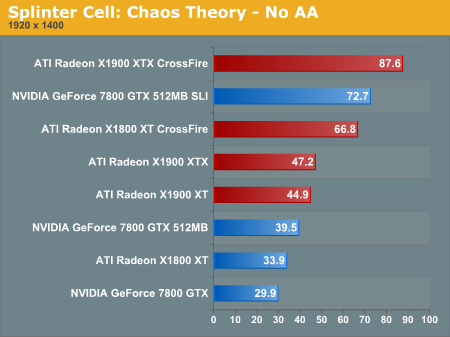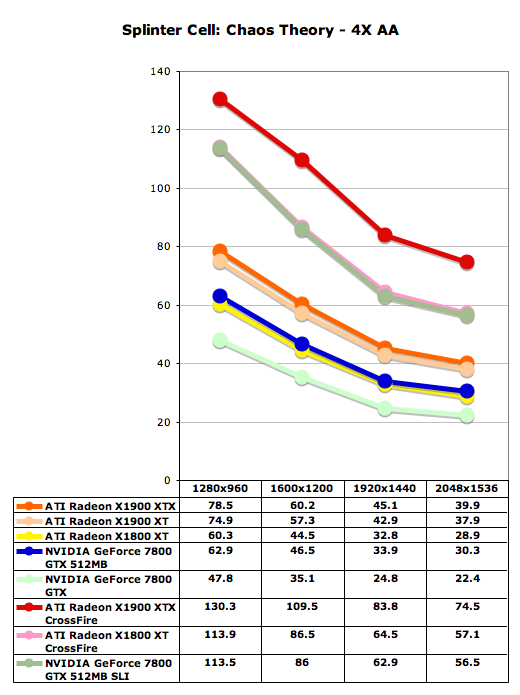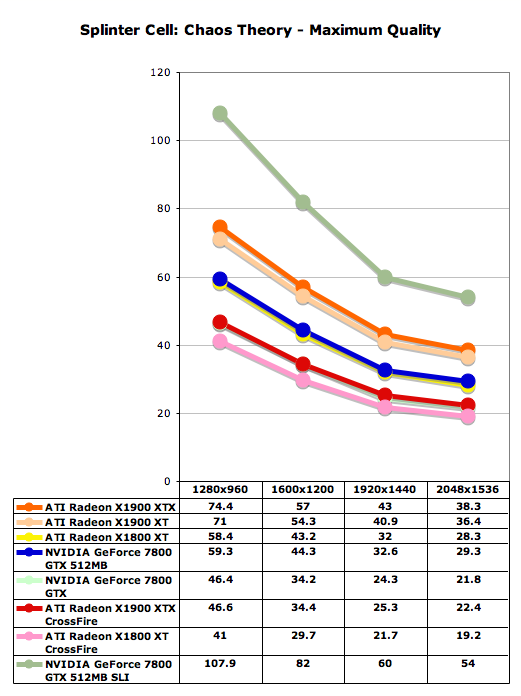ATI's New Leader in Graphics Performance: The Radeon X1900 Series
by Derek Wilson & Josh Venning on January 24, 2006 12:00 PM EST- Posted in
- GPUs
Splinter Cell: Chaos Theory Performance
Splinter Cell: Chaos Theory provides us with a benchmark for a different type of game. Stealth and patience are the themes in this game, and this gives us an alternative to other fast-pace, action-oriented games. Variety is important when considering graphics performance, and games like these offer us just that.
Because this game is somewhat slow-paced, a framerate of around 19 or 20 fps isn't that bad. This is a good thing, because with even the highest settings none of these cards go below this number. For the most part, the Crossfire and SLI setups do very well, with ATI doing better than NVIDIA with and without 4xAA.



Splinter Cell: Chaos Theory provides us with a benchmark for a different type of game. Stealth and patience are the themes in this game, and this gives us an alternative to other fast-pace, action-oriented games. Variety is important when considering graphics performance, and games like these offer us just that.
Because this game is somewhat slow-paced, a framerate of around 19 or 20 fps isn't that bad. This is a good thing, because with even the highest settings none of these cards go below this number. For the most part, the Crossfire and SLI setups do very well, with ATI doing better than NVIDIA with and without 4xAA.
















120 Comments
View All Comments
Live - Tuesday, January 24, 2006 - link
Thanks for the explanation! Derek I think this merits a mention in the review.NullSubroutine - Tuesday, January 24, 2006 - link
perhaps a flash system where you can pick the card within the benchmark and it will show it on the line graph. just simply activate/deactivate feature.bldckstark - Tuesday, January 24, 2006 - link
I have to agree that a group color for the multi-GPU setups would be helpful on the bar graphs. The outline you used to denote negative gains would work well for this. Then ATI and Nvidia bars would still have a different major color, but the multi-GPU setups could have a yellow outline. E.G. ATI = red, ATI X-fire = Red w/ yellow outline, Nvidia = blue, Nvidia SLI = blue w/ yellow outline.Rock Hydra - Tuesday, January 24, 2006 - link
I don't know if you meant this or not, on the page mentioning the new crossfire board. There is url, I don't know if it was intended to be active or plain text, but I thought I would just bring that to your attention.DerekWilson - Tuesday, January 24, 2006 - link
thanks, fixedemilyek - Tuesday, January 24, 2006 - link
Good article.You have two typos in your article.
In the system specs you have OZC Powerstreams instead of ...stream
When you use the words 'eek out' as a verb that means 'squeeze out', it is spelled 'eke'-- 'eke out'.
DerekWilson - Tuesday, January 24, 2006 - link
I had no idea there was a correct spelling for eke ...thanks
beggerking - Tuesday, January 24, 2006 - link
Did anyone notice it? the breakdown graphs doesn't quite reflect the actual data..the breakdown is showing 1900xtx being much faster than 7800 512, but in the actual performance graph 1900xtx is sometimes outpaced by 7800 512..
DerekWilson - Tuesday, January 24, 2006 - link
We didn't aggregate performance of each card under each game.for the percent improvment breakdown we only looked at 2048x1536 with 4xAA which clearly shows the x1900xtx in the lead.
our reasoning is that this is the most stressful stock test we throw at the cards -- it shows what the cards can handle under the highest stress.
beggerking - Tuesday, January 24, 2006 - link
umm.. what about 8xAA or higher? or lower resolution? w/wo AA?if you don't aggregate performance, then won't the graphic be misleading?
isn't max quality the most stressful test ?